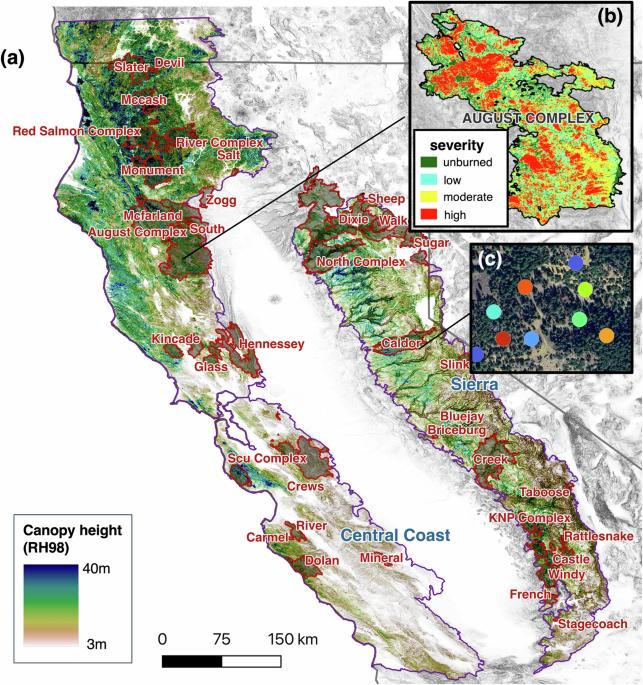Ladder fuels rather than canopy volumes consistently predict wildfire severity even in extreme topographic-weather conditions
IF 8.1
1区 地球科学
Q1 ENVIRONMENTAL SCIENCES
引用次数: 0
Abstract
Drivers of forest wildfire severity include fuels, topography and weather. However, because only fuels can be actively managed, quantifying their effects on severity has become an urgent research priority. Here we employed GEDI spaceborne lidar to consistently assess how pre-fire forest fuel structure affected wildfire severity across 42 California wildfires between 2019–2021. Using a spatial-hierarchical modeling framework, we found a positive concave-down relationship between GEDI-derived fuel structure and wildfire severity, marked by increasing severity with greater fuel loads until a decline in severity in the tallest and most voluminous forest canopies. Critically, indicators of canopy fuel volumes (like biomass and height) became decoupled from severity patterns in extreme topographic and weather conditions (slopes >20°; winds > 9.3 m/s). On the other hand, vertical continuity metrics like layering and ladder fuels more consistently predicted severity in extreme conditions – especially ladder fuels, where sparse understories were uniformly associated with lower severity levels. These results confirm that GEDI-derived fuel estimates can overcome limitations of optical imagery and airborne lidar for quantifying the interactive drivers of wildfire severity. Furthermore, these findings have direct implications for designing treatment interventions that target ladder fuels versus entire canopies and for delineating wildfire risk across topographic and weather conditions. Wildfire severity is more consistently associated with vertical fuel continuity metrics such as ladder fuels rather than total canopy volumes across a range of topography and weather conditions, according to an analysis of GEDI spaceborne lidar data for 42 California fires between 2019–2021.

即使在极端地形-天气条件下,阶梯燃料而非树冠体积也能持续预测野火的严重程度
森林野火严重程度的驱动因素包括燃料、地形和天气。然而,由于只能对燃料进行积极管理,因此量化燃料对严重程度的影响已成为研究的当务之急。在此,我们利用 GEDI 空间激光雷达对 2019-2021 年间加利福尼亚州 42 场野火中的火前森林燃料结构如何影响野火严重程度进行了持续评估。利用空间-层次模型框架,我们发现 GEDI 衍生的燃料结构与野火严重性之间存在正的凹向下关系,其特征是随着燃料负荷的增加,严重性也随之增加,直到最高、最多的林冠严重性下降为止。重要的是,在极端地形和天气条件下(坡度 20°;风速 9.3 米/秒),树冠燃料量指标(如生物量和高度)与严重程度模式脱钩。另一方面,垂直连续性指标(如分层和阶梯状燃料)在极端条件下更一致地预测了严重程度--尤其是阶梯状燃料,稀疏的林下植被一致与较低的严重程度相关。这些结果证实,GEDI 衍生的燃料估算可以克服光学成像和机载激光雷达在量化野火严重程度的交互驱动因素方面的局限性。此外,这些发现还对设计针对阶梯燃料和整个树冠的处理干预措施以及在不同地形和天气条件下划分野火风险具有直接影响。根据对2019-2021年间加利福尼亚州42起火灾的GEDI空间激光雷达数据分析,在一系列地形和天气条件下,野火严重程度与垂直燃料连续性指标(如阶梯燃料)而非树冠总体积的关系更为一致。
本文章由计算机程序翻译,如有差异,请以英文原文为准。
求助全文
约1分钟内获得全文
求助全文
来源期刊

Communications Earth & Environment
Earth and Planetary Sciences-General Earth and Planetary Sciences
CiteScore
8.60
自引率
2.50%
发文量
269
审稿时长
26 weeks
期刊介绍:
Communications Earth & Environment is an open access journal from Nature Portfolio publishing high-quality research, reviews and commentary in all areas of the Earth, environmental and planetary sciences. Research papers published by the journal represent significant advances that bring new insight to a specialized area in Earth science, planetary science or environmental science.
Communications Earth & Environment has a 2-year impact factor of 7.9 (2022 Journal Citation Reports®). Articles published in the journal in 2022 were downloaded 1,412,858 times. Median time from submission to the first editorial decision is 8 days.
 求助内容:
求助内容: 应助结果提醒方式:
应助结果提醒方式:


